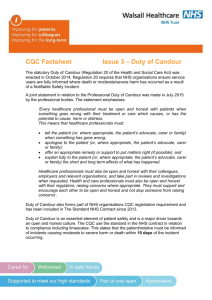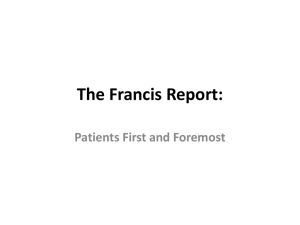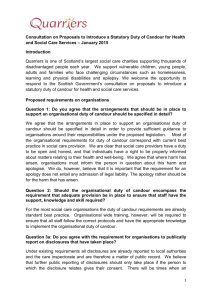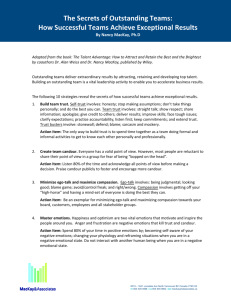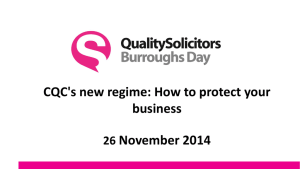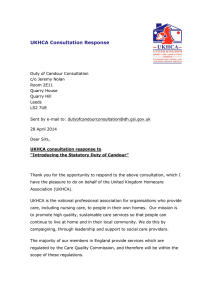Trust Board Meeting: Wednesday 14 January 2015 TB2015.15 Title
advertisement
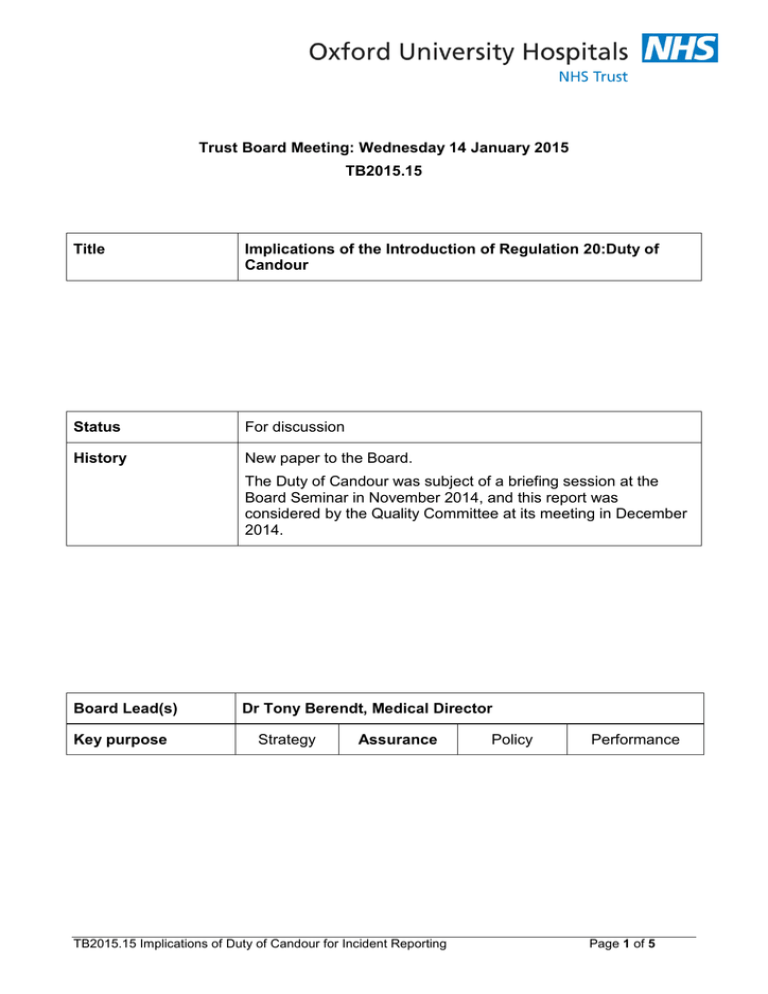
Trust Board Meeting: Wednesday 14 January 2015 TB2015.15 Title Implications of the Introduction of Regulation 20:Duty of Candour Status For discussion History New paper to the Board. The Duty of Candour was subject of a briefing session at the Board Seminar in November 2014, and this report was considered by the Quality Committee at its meeting in December 2014. Board Lead(s) Key purpose Dr Tony Berendt, Medical Director Strategy Assurance TB2015.15 Implications of Duty of Candour for Incident Reporting Policy Performance Page 1 of 5 Oxford University Hospitals TB2015.15 Executive Summary 1. The purpose of this paper is to provide an overview of the new CQC regulation: Duty of Candour and the actions required within the Trust to ensure compliance. 2. The aim of this regulation is to ensure that health service bodies are open and transparent with the ‘relevant person’ when certain incidents occur in relation to the care and treatment provided to people who use services in the carrying on of a regulated activity. 3. It is proposed that there are five Trust policies that need to be reviewed and amended in response to the regulation. There will be training implications for staff once this work is complete. There will also be practical implications related to the need to design a process to document “candour discussions” and to notify them for assurance purposes. 4. Recommendation The Board is asked to review the report and discuss the mechanism for monitoring compliance with the regulation. TB2015.15 Implications of Duty of Candour for Incident Reporting Page 2 of 5 Oxford University Hospitals TB2015.15 Introduction of Regulation 20: Duty of Candour 1. Purpose 1.1. The purpose of this paper is to provide an overview of the new CQC regulation: Duty of Candour and the actions required within the Trust to ensure compliance. 2. Background 2.1. The Duty of Candour requirement came into force on the 27 November 2014. It places a legal duty on a hospital to inform and apologise to patients if there have been mistakes in their care that have led to harm. 2.2. The introduction of Regulation 20: Duty of Candour is a direct response to recommendation 181 of the Francis Inquiry report into Mid Staffordshire NHS Foundation Trust which recommended that a statutory duty of candour be imposed on healthcare providers. 2.3. The aim of the regulation is to ensure the health service bodies are open and transparent with the ‘relevant person’ when certain incidents occur in relation to the care and treatment of patients. 3. Requirements of the Regulation 3.1. In summary to meet the requirements of this regulation the Trust has to: • Recognise the event involving the patient as an incident • Establish that is has caused harm • Act in an open and transparent way with the ‘relevant person’. • Tell the ‘relevant person’ as soon as reasonably practicable after becoming aware that a notifiable safety incident has occurred and provide support to them. • Provide an account of the incident. • Advise the ‘relevant person’ what further enquiries the Trust believes are appropriate. • Offer an apology. • Follow this up by giving the same information in writing, and providing an update on enquiries. • Keep a written record of all communication with the ‘relevant person’. 3.2. The CQC will assess whether there is an understanding of the regulation within the organisation. This will involve a review of the systems in place using the following “Safe” and “Well-led” questions: • Are lessons learned and improvements made when things go wrong? • How does the leadership and culture reflect the vision and values, encourage openness and transparency and promote good quality care? 4. Definitions 4.1. The following key terms have been defined by CQC: Term Definition Openness Enabling concerns and complaints to be raised freely without fear and questions asked to be answered. TB2015.15 Implications of Duty of Candour for Incident Reporting Page 3 of 5 Oxford University Hospitals Term Definition Transparency Allowing accurate information about performance and shared with staff, patients, the public and regulators . Candour any patient harmed by the provision of a healthcare service is informed of the fact and an appropriate remedy offered, regardless of whether a complaint has been made or question asked about it Notifiable incident 5. TB2015.15 safety outcomes to any unintended or unexpected incident that occurred in respect of a service user during the provision of a regulated activity that could result in or appears to have resulted in death,, severe harm, moderate harm or prolonged psychological harm to the service user; Policy implications 5.1. In response to the regulation the following Trust policies require review: Policy Current approval date Executive Lead Being Open Policy June 2012 Medical Director Incident Reporting and Investigation Policy February 2014 Medical Director Claims Management Policy June 2012 Director of Assurance Management of Patients Comments, Concerns and Complaints Policy and Procedure June 2012 Chief Nurse Patient Experience Strategy 2014 Chief Nurse Raising Policy August 2013 Director of Organisation Development and Workforce Concerns (Whistleblowing) 5.2. The Duty of Candour will have far reaching implications for all staff in terms of understanding the nature of incidents the definitions of harm and the level of support that can be offered to the individual affected by the incident. Following the changes to policies, a number of actions will be required. These will include, but may not be limited to: • • • • 6. The review of the current education programme across the organisation to ensure the incident reporting processes are more fully understood. The review of the supporting documentation and information that is provided to all staff in relation to incident reporting and the interaction with the ‘relevant person’. A review of the level of support and advice provided to staff to enable them to provide appropriate support to the ‘relevant person’. A review of the Trust incident reporting system. Practical implications 6.1. In addition to the policy implications above, the specific steps set out in section 3 will require the design of a process to capture the clinical conversations, ensure the issuing of the written confirmation, and link these to an audit trail and reporting function (for Trust assurance and regulator oversight), as well as providing a means to store the written documents securely 6.2. It is proposed that this will be addressed by the urgent design of a proforma for data capture and a process. TB2015.15 Implications of Duty of Candour for Incident Reporting Page 4 of 5 Oxford University Hospitals TB2015.15 6.3. As the discussion is taking place with the patient in an open and transparent way, there appears no reason that a copy of the written confirmation should not be filed in the patients notes. 6.4. In view of this, a data collection and document generation process involving the Electronic Patient Record is expected to allow all the practical requirements above including data extraction for reporting and assurance. Discussions are underway with the Chief Clinical Information Officer and EPR team. 6.5. This will be important in view of the number of incidents that will fall within the bounds of the Duty of Candour. The table below shows the number of incidents causing moderate harm or worse for the period April to October 2014: Division MRC NTOSS CSS C&W S&O Total Trust wide Incidents of moderate or greater harm during April to October 2014 Estimated full year number 127 103 32 42 103 407 217 175 55 72 175 694 6.6. On this basis, the three larger Divisions will each on average be holding 3-4 “candour discussions” a week. 7. Recommendation 7.1. The Board is asked to review the report and discuss the mechanism for monitoring compliance with the regulation. Dr Tony Berendt, Medical Director January 2015 Report prepared by: Clare Winch Deputy Director of Assurance TB2015.15 Implications of Duty of Candour for Incident Reporting Page 5 of 5
